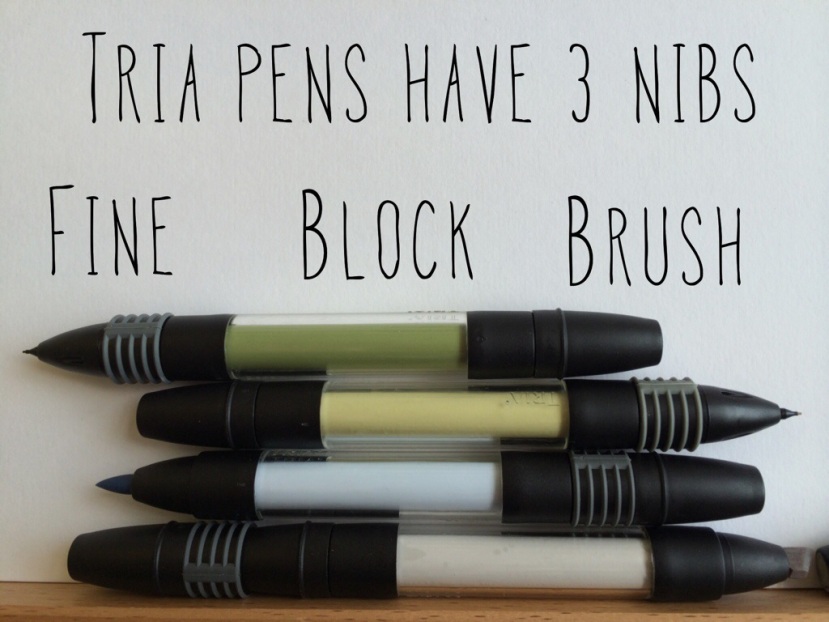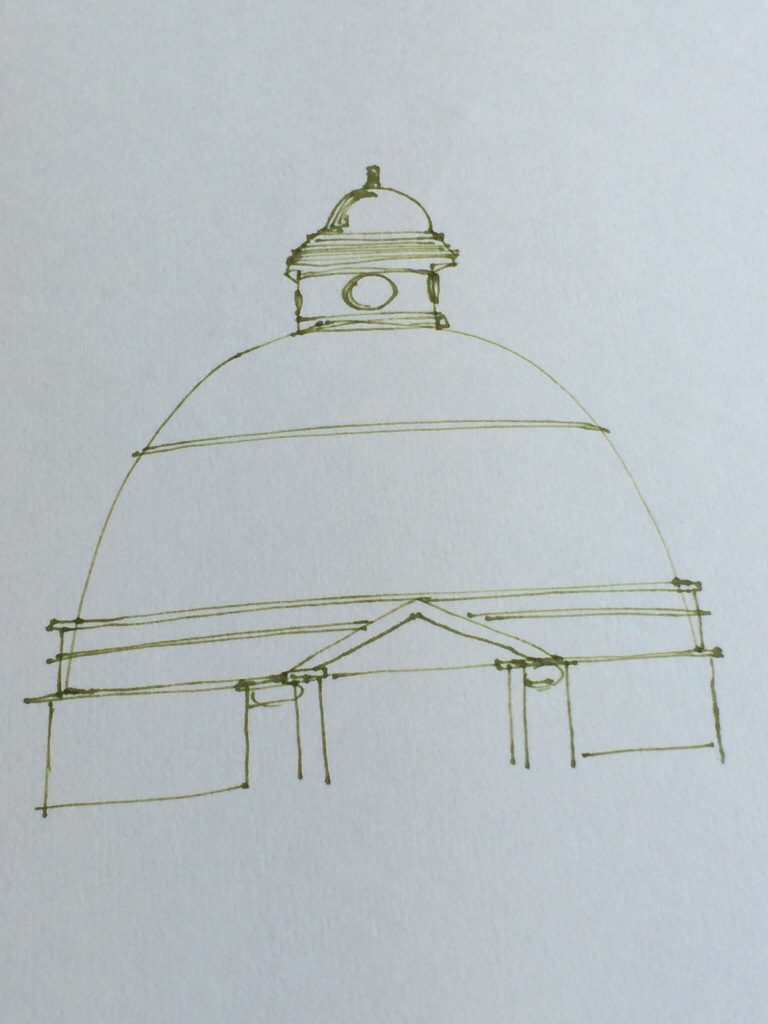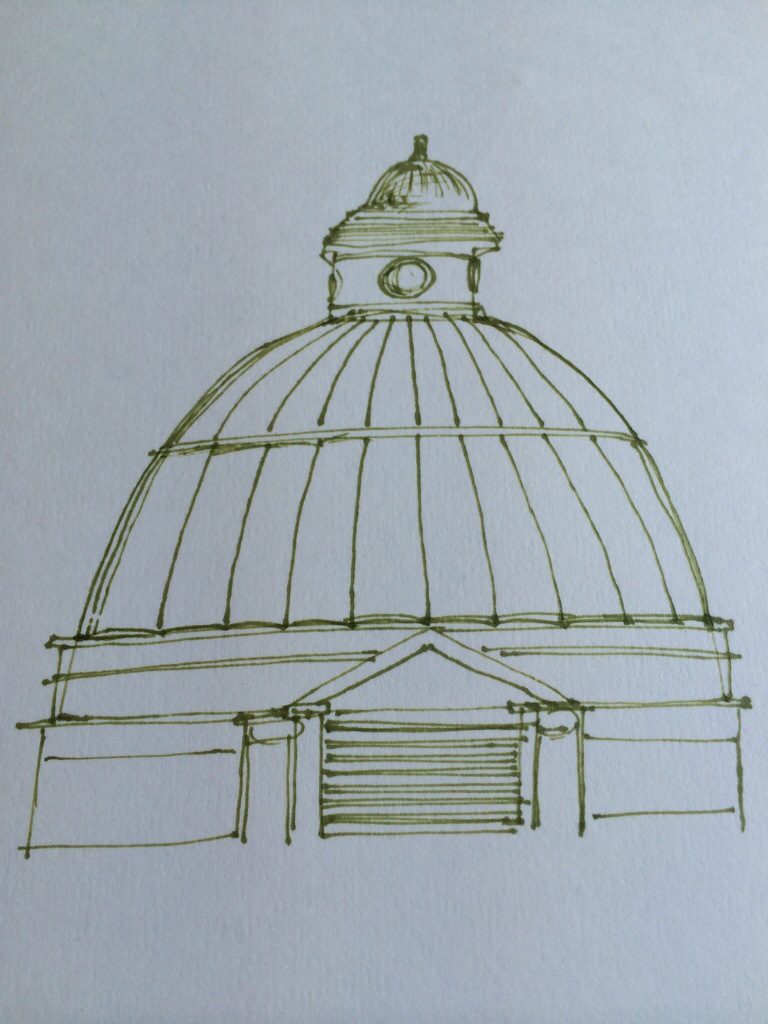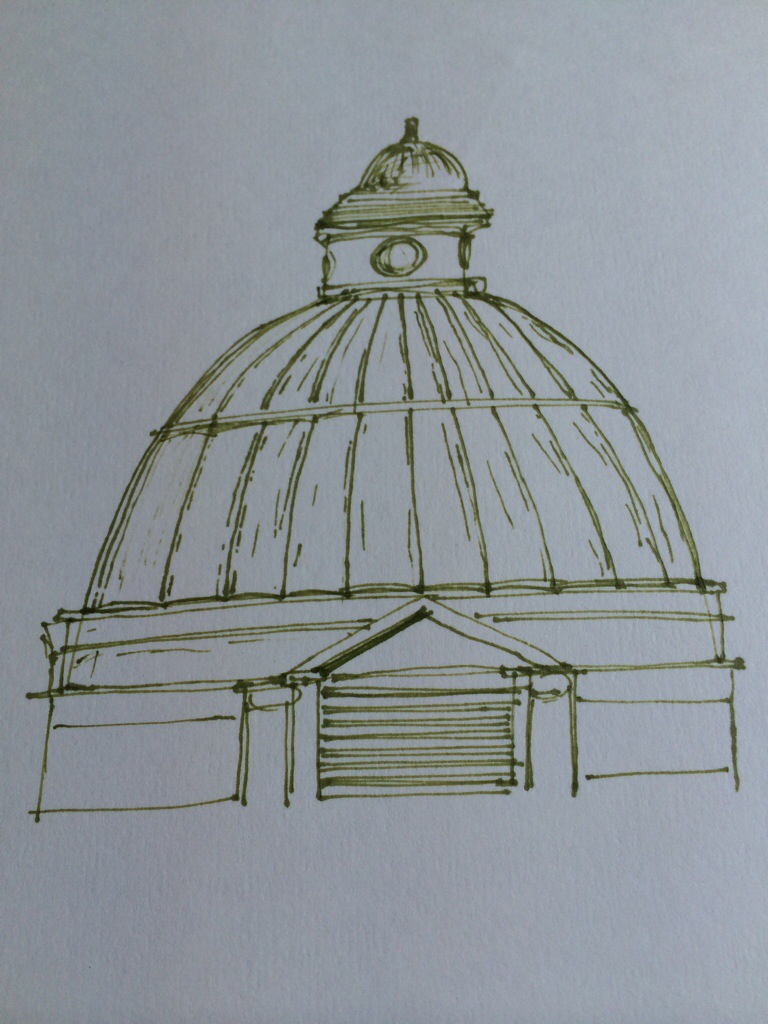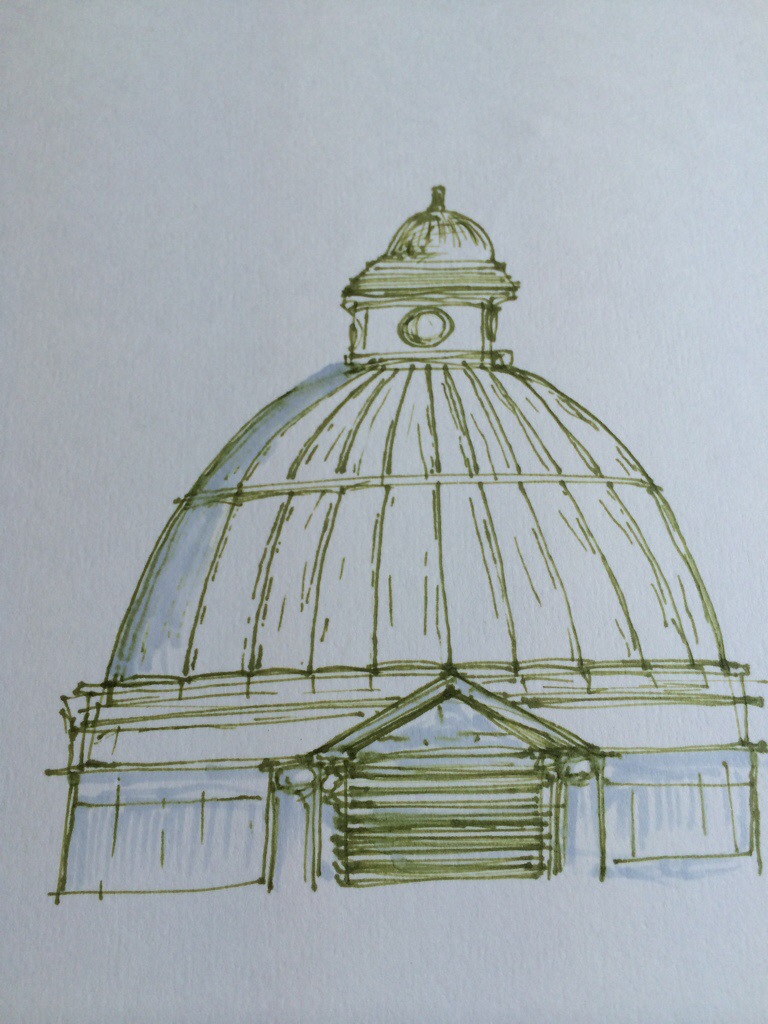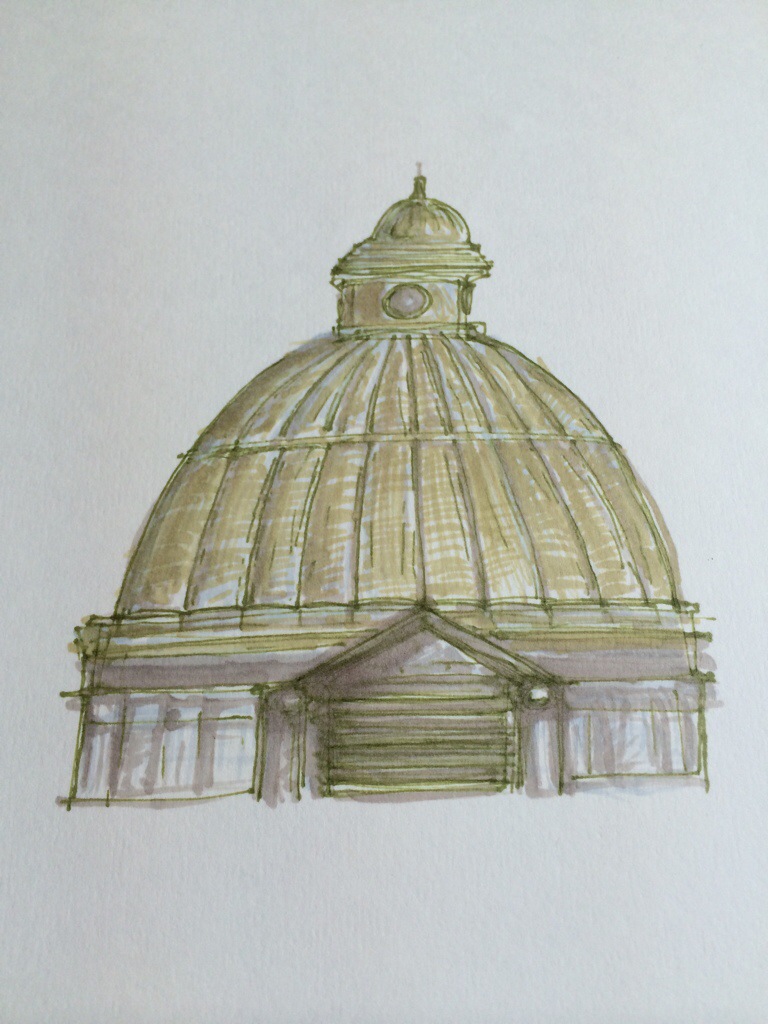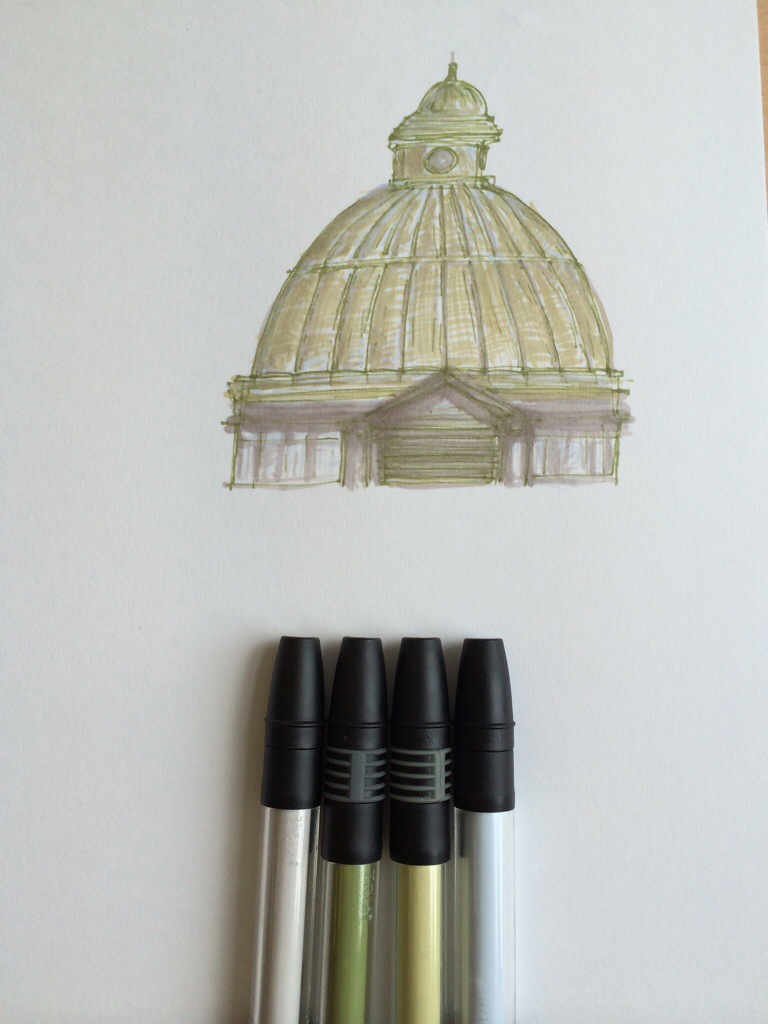Tagged: art

Drawing a roofscape in Letraset Tria pens
I have been experimenting with new art materials and very much enjoying the effects which one can achieve by using Letraset pens. I fondly remember the Letraset brand as something which involved lots of rubbing and transfers to make beautiful (if often wonky, given uncareful placement) words and phrases. I also remember trying to make a local plan diagram from rubbing patterned Letraset, it made trees and everything! You can still buy such goodies, but they are perhaps not such a prominent tool in many designer or technicians tools now that computers can do the same thing. One day I will make a “retro” plan illustration with these, just because it’s still possible. The town planner in me has always been creative, the creative in me has always sought out socially aware , useful and enjoyable outlets for my work!
The tria pens come in lovely boxes, there is an “architecture” set which I was kindly given a gift of time ago. I was almost scared to use them because they are so beautiful. Pens are, however, designed to be loved and used… And I have been experimenting with the older pens and some recent acquisitions.
The view from my studio has a particularly nice dome in sight, which as someone who revels in architectural drawing is a challenge begging to be explored. I usually go for black sketching pen and then a watercolour lining, but today the Letraset pens were beckoning.
Materials:
Daler-Rowney smooth cartridge paper (at least 150 gsm)
Letraset Tria- G136, Y516, WG07 and C919
Method:
Start out with an outline drawing of the dome in the lift green colour. This may seem an unconventional choice for line drawing, but as the dome is constructed with copper, which has taken on a patina or age over time, the green reflects this tinge. Concentrate on the symmetrical appearance, but a little artistic licence won’t disturb the overall affect here and there (this is a freehand representation, drawn with love, not a “to scale” model after all).
Add the lines for the dome construction, forming the individual sections of the dome
Continuing to use the fine nib, press lightly to imply structure and form, adding short dashes of line to the dome.
Use the more blue coloured C919 marker to add tones of leadwork to the base of the dome, including the triangular pediment. Lead has different Material properties and is often laid in sheets; reflect this in the lines you use.
Having added more structure to the drawing, it is time to add shadow. Use the brush end of the same pen to add wider swoops of colour, implying shadow.
Continue adding colour, noticing the angle of the shadows. The next stage is to use an alternative colour, Y516, to add a more realistic colour and start to define each part of the structure. The copper is slightly curved on the dome; add lines with the fine tip to imply curved areas. The dome is a greener colour than the lead below, so the new colours reflect this. Occasional areas of brush can be used to add shadow.
Use the last pen (brush tip) to emphasise any areas of shadow and continue tinkering until you are happy.
That’s it!
Part 2 of this entry is ” make it digital”…
Fun at the festival of museums
This weekend it has been the Festival of Museums throughout Scotland (and Museums at Night throughout the UK). We had a great time yesterday (May 17th) on an architectural art bus tour organised by the Glasgow Gallery of Modern Art, and hosted by Dress for the Weather architects. There is currently an exhibition at GOMA by Nathan Coley, using the architectural form of places of worship in Edinburgh to form a dramatic model landscape, our tour was inspired by this and we visited two religious buildings in the South Side of Glasgow (Glasgow Gurdwara and Govan Old).
I have included a taster of some of the sketches and models in the video, but I am looking forward to seeing them all on display in GOMA together.
Artist Call: experimental, participatory or collaborative practice
Artist Call: experimental, participatory or collaborative practice.
I saw this today and think it is a wonderful idea. Built environment and urban change from a suitcase!
What does creativity sound like?
I like to work with music when I am typing.. recently I have been listening to Spotify playlists. This afternoon I am putting the finishing touches to a proposal which I hope is successful. I like this playlist called ‘creativity boost’, it has a nice mixture of uplifting, happy and hoppy songs, with some artists which I had not heard until today. What would you put on your playlist? What does Creativity sound like to you?
My life in a museum? 30 days of biking sightseeing
architectural cycling sightseeing!
Day 27 of day 30, a day of cycling sightseeing combining art, architecture, digital photos and cycling. I went to see the Glasgow architectural masterpiece which is Scotland Street School. This is a wonderful and free tourist attraction, easily accessible from the city centre via cycle routes from Bells Bridge, and also subway (it is opposite Shields Road station). It is not your ordinary school, it was designed by Charles Rennie Mackintosh and is fitted as a museum with class room s from various periods (Victorian to 1960’s).
There are wonderful architectural details, typical of Mackintosh, with nature inspired motifs, vibrant colours and Locharbriggs red sandstone.
View original post 329 more words
Experiments and reflections on digital media community exploration
As someone with a huge passion for exploring my local environment and digging into the history and architecture of an area, and ways of presenting this creatively I am rather taken by a project which I found on Twitter called “Walk My World”, the invention of William O’Byrne who is based in Newhaven, USA. The idea is that you carry out a journey, once a week, and then record and share that using various digital media tools (he suggests Twitter, Vine and Instagram and produces a handy guide for newcomers to these on his site). There’s still an opportunity to take part if you wish… join in!
I personally have not used Instagram much as until fairly recently I didn’t have a phone with a very good camera (it was quite a low resolution), preferring to play with my SLR, but since I got a new phone in November I have been playing with the many free and low cost apps which allow you to snap, shoot and share your view of the world. The Walk My World project seemed a good time to try out Instagram.. so I took a wander around Govanhill in Glasgow.
A wonderful multi-lingual community cafe, in an Evangelical church hall, which asks for only donations for breakfast:
Said free/ donation breakfast (which was lovely, as were all the people in the pop up cafe):
Library exhibition on wartime experiences:
The library history exhibition, including a little alcove devoted to R D Laing, an influential psychiatrist born in the area:
The many languages of Govanhill:
International peace garden:
Community baths (I had visited these at Doors Open Day before):
Wonderful tenements, a Glasgow architectural icon:
I discovered a lot about the area, even from this short walk! I had not created a video in Instagram before, and also played with the tagging and mapping functions. I know Instagram is not exactly “new news” but it is funny how sometimes we need a reason to play with new stuff. I also learnt that embedding Instagram posts in WordPress only needs the URL, not the embed code. I like to learn through play, and this sort of project is “right up my street”, thanks William!
I completely agree with the comment in William’s blog post that educators should create an online brand for themselves (thinking before they share), I am quite aware of my “digital footprint” and in some ways my background may appear somewhat diverse (town planning, conservation, education, creative media) but I am lucky enough to be able to combine all of these through the various strands of my professional work (on reflection, I am needing to revisit my own website to better represent this; although I was very happy with it when I created it at the time and I have gradually added content such as my “Are You Here” project exploring family history links and the environment of Bristol and Brighton, my professional practice has evolved to represent a variety of skills).
As well as undertaking freelance illustration and digital interpretation projects in arts and heritage, and volunteering my time for Planning Aid Scotland, in my other professional persona I am currently working as Educational Co-ordinator at the University of the West of Scotland, on the Digital Commonwealth project. This is a project which is designed to help marginalised communities (such as those who live in areas of socio-economic deprivation) develop digital media literacy skills using readily available technology and tools. The project is framed around the digital reporting of Queen’s Baton Relay for the Glasgow 2014 Commonwealth Games, with projects based around the topics of people, place, culture and exchange. I have been really impressed with the creative results of the #walkmyworld project beginning to be shared on Twitter and it made me even more excited about the possible results of planned creative digital media projects which will take place as part of the Digital Commonwealth project!
Here are some of my favourite #Walkmyworld posts so far:
Vine poetry:
Happy Twitter dogs!
I think my rescued pups Watson and Tyson are ready to #walkmyworld with #ENGL3241! pic.twitter.com/tOMg7T5GJD
— Caitlyn Keller (@CatierayeK) January 13, 2014
More dogs (but Vine):
The wonders of Islay:
#islay#beauty#lifeisbeautiful#glen#loch#oa#scotland#walkmyworld#happy#nature#winter#island#lifepic.twitter.com/mJEHbfRlBE
— Emma Revie (@EmmaReviex) January 16, 2014
The fabulous benefits of creating enthusiastic online communities!
“@_mlsg: #walkmyworld the kids who I inspire, continue to push and inspire me. pic.twitter.com/A6qKmd0Giz” #eng152
— Molly Shields (@ShieldsMolly) January 18, 2014
Happy exploring, creating, learning and sharing!
In praise of free: December 17th unconventional advent calendar
Today’s unconventional advent calendar celebrates our cultural venues, formal and informal, and their place in the life of the community.
I personally feel quite at home in arts venues but to some they can be alien spaces with an unwelcoming or elitist feel. Living in Glasgow, I am very lucky to have a huge range of free museums and galleries on my doorstep, so I do make an effort to see the wonderful range of free events which are on. I feel that free facilities and events are really important for people to be able to have the chance to see new cultural events and explore their area without the added barrier of cost. That can be one reason why I don’t tend to visit the theatre or cinema much, I have to really want to see something to justify spending money on seeing something which is not free! It is also why I love events like Doors Open Day, every September buildings are open for tours and events at no cost throughout Scotland (and Europe!).
Independent cafes and other small community halls or spaces can be really important in what makes the cultural map of a place work, where activities and get togethers are easy to organise and local groups or artists can sell or showcase their newest creations. It’s not free to have coffee, of course, but I’ve seen some great free events at local cafes.
Do you have a favourite free venue?
Unstable buildings and cultural festivals
Today’s unconventional advent calendar is very unconventional indeed as it is long weekend of cumulative entries. I may well devise some bonus content later for those of you who might have missed the last two days of usually daily pics and musings.
I was taken by the art featured in the calendar as someone who endeavours to unite art and planning issues; often we find ourselves working with various people who have ideas for new uses for buildings where the previous use has for some reason ceased, and unfortunately there are a lot of examples of buildings which are at risk due to continual neglect and decay. From a cultural planning point of view these can also present themselves as opportunities as well as problems, there are many innovative examples of property re-use and reimagination. Our towns and cities are constantly changing, instability can mean an area reinvents itself in various ways. The Liverpool biennial is the largest contemporary arts festival in the UK (see website), and when I first visited in 2008 the city was the European capital of culture. Interestingly, Liverpool and Liverpool John Moores Universities devised a methodology for assessing the impact of cultural festivals (download here), covering cultural access, economy and tourism, cultural vibrance and sustainability, image and perceptions and governance and delivery.
Previous entries for the unconventional advent calendar can all be seen on the UWS Cultural Planning blog where a community of cultural planning practitioners doing the 2013 short course are recording and sharing their reflections and thoughts.
Exhibition- Are You Here, Gladstone’s Land Gallery, Edinburgh
I am currently showing my latest work at the Gladstone’s Land Gallery, Lawnmarket, Edinburgh (on the Royal Mile). The exhibition showcases some of the illustration work which I developed from my genealogical travels, and also a preview of my e-book which accompanies the exhibition.
Hope to see you here… do come along if you happen to be in Edinburgh!
Travels, moves, cycling and other transportation
So, when I was in Bristol I commented on how much I liked my “bike experience” there, and a few people (James Corner and Calmgrove, do check out their blogs) mentioned I should seek out the cycle map. I do indeed rather like it, a 3D view of all of the major cycle routes.
The map is located by the new square, which contains @Bristol and the planetarium; it made me think about the big distances which my family have moved over time, something I am considering for my art project. How did they get where they were going and why did they go there? Where have your family moved to or from? Do you have any exciting genealogical adventures to share?
My bike needs to get out, it is feeling sad attached to the railings where I am staying! I have been walking everywhere here.
